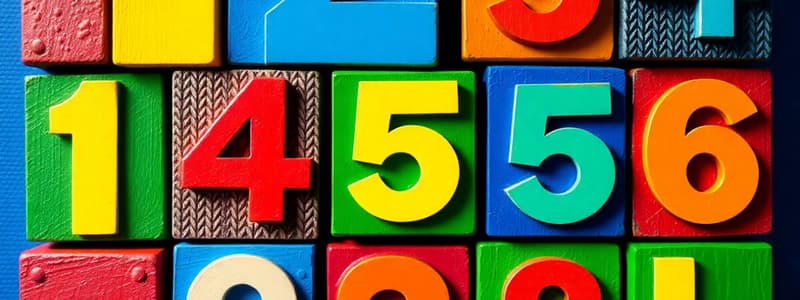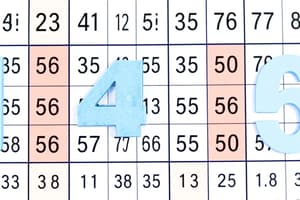Podcast
Questions and Answers
What is the main purpose of understanding place value when working with large numbers?
What is the main purpose of understanding place value when working with large numbers?
- To decompose and recompose numbers, making them easier to understand. (correct)
- To make the numbers appear larger.
- To confuse the reader with complex digits.
- To avoid using visual aids.
Which of the following is a visual aid used to represent numbers?
Which of the following is a visual aid used to represent numbers?
- Calculator
- Protractor
- Ruler
- Base-ten blocks (correct)
What does a 'flat' represent when using base-ten blocks?
What does a 'flat' represent when using base-ten blocks?
- One hundred (correct)
- Ten
- One
- One thousand
How do numbers increase in value on a number line?
How do numbers increase in value on a number line?
What is the purpose of a place value chart?
What is the purpose of a place value chart?
What should you do to improve readability when writing large numbers?
What should you do to improve readability when writing large numbers?
When reading a large number such as 5,342,801, where do you start?
When reading a large number such as 5,342,801, where do you start?
In the number 1,250,000, what place value does the digit '2' represent?
In the number 1,250,000, what place value does the digit '2' represent?
What is a common misconception students have when dealing with zeros in large numbers?
What is a common misconception students have when dealing with zeros in large numbers?
What strategy can help in understanding and comparing large numbers?
What strategy can help in understanding and comparing large numbers?
Flashcards
Place Value
Place Value
The value a digit has based on its position in a number (ones, tens, hundreds, etc.).
Base-Ten Blocks
Base-Ten Blocks
Visual aids that represents numbers, useful for arithmetic operations.
Number Lines
Number Lines
Visuals that arrange numbers sequentially, useful for comparing values and illustrating addition/subtraction.
Place Value Charts
Place Value Charts
Signup and view all the flashcards
Reading Large Numbers
Reading Large Numbers
Signup and view all the flashcards
Writing Large Numbers
Writing Large Numbers
Signup and view all the flashcards
Grouping/Estimation
Grouping/Estimation
Signup and view all the flashcards
Common Misconceptions
Common Misconceptions
Signup and view all the flashcards
Technology Integration
Technology Integration
Signup and view all the flashcards
Practice Activities
Practice Activities
Signup and view all the flashcards
Study Notes
- Focus on visualizing and understanding numbers, particularly within the range of 100,001 to 10,000,000, while also covering numbers up to 10,000,000 in general.
Understanding Place Value
- Place value serves as the basis for visualizing large numbers.
- Each digit in a number has a specific place value, including ones, tens, hundreds, thousands, ten thousands, hundred thousands, and millions.
- Understanding place value aids in breaking down and reconstructing numbers for better understanding.
- A digit's position dictates how much it contributes to the total value of the number.
- In 5,281, the 5 represents 5,000 (five thousands), the 2 represents 200 (two hundreds), the 8 represents 80 (eight tens), and the 1 represents 1 (one).
Visual Representation Techniques
- Visual aids like base-ten blocks, number lines, and place value charts can be used to represent numbers.
Base-Ten Blocks
- Base-ten blocks are physical tools used to represent ones, tens, hundreds, thousands, and larger values.
- A small cube indicates a one.
- A long (or rod) indicates ten ones.
- A flat indicates one hundred ones (ten tens).
- A large cube indicates one thousand ones (ten hundreds).
- Base-ten blocks can be expanded to represent larger units like ten-thousand and hundred-thousand blocks, but these are difficult to handle physically and visualize.
- Base-ten blocks are useful for visualizing the composition and decomposition of numbers, as well as performing arithmetic operations.
Number Lines
- Number lines visually represent numbers sequentially along a line.
- Number lines can represent whole numbers, fractions, decimals, and integers.
- Number lines can be scaled to represent different ranges, such as 0 to 10, 0 to 100, or 0 to 1,000,000.
- On a number line, values increase from left to right.
- Number lines are suitable for illustrating addition and subtraction, as well as comparing numbers.
Place Value Charts
- Place value charts organize digits based on their place value.
- Headings in the chart show the place value, such as ones, tens, hundreds, thousands, ten thousands, hundred thousands, and millions.
- Number digits are placed in the corresponding columns based on their place value.
- Place value charts assist in reading and writing numbers, especially large ones.
- Place value charts can be expanded to represent numbers with decimal places.
Representing Numbers up to 10,000,000
- Place value understanding is critical to read and write numbers.
- Recognize base-ten number system patterns.
- Each place value is ten times greater than the place value to its right.
- Commas or spaces separate groups of three digits (thousands, millions) for readability.
Reading Large Numbers
- Begin with the leftmost digit and read each group of three digits (millions, thousands, ones).
- For example, 5,342,801 is read as "five million, three hundred forty-two thousand, eight hundred one."
- Clearly state the place value of each digit group.
Writing Large Numbers
- Break the number down into its place value components.
- Write the digit for each place value, starting from the leftmost digit.
- Use zeros as placeholders for any missing place values.
- Use commas or spaces to separate groups of three digits.
Emphasis on Numbers 100,001 – 10,000,000
- Includes numbers from one hundred thousand and one to ten million.
- Focus on understanding hundred thousands and millions place values.
- Practice reading, writing, and comparing numbers within this range.
- Develop proficiency in decomposing and recomposing numbers in this range.
Visualizing Numbers in the 100,001 – 10,000,000 Range
- Use place value charts extensively.
- Use appropriately-scaled number lines.
- Consider technology to represent large quantities visually.
- Group numbers into manageable chunks (e.g., think of 1,000,000 as 1,000 thousands).
- Relate these numbers to real-world contexts like population sizes or monetary amounts.
Real-World Applications
- Relate large numbers to real-world scenarios to enhance understanding.
- Examples include the population of cities or countries, national debt, company revenue, and distances between planets.
- Aids in understanding the magnitude and significance of large numbers.
Grouping and Estimation Techniques
- Grouping and estimation can simplify understanding and comparison of large numbers.
- Round numbers to the nearest thousand, ten thousand, or million for easier comprehension.
- Use benchmark numbers to estimate and compare quantities.
- Compare to nearby millions to quickly assess a number’s magnitude.
Common Misconceptions
- Students may struggle with place value, especially with zeros.
- Students may misread or miswrite large numbers due to incorrect use of commas or spaces.
- Students may struggle comparing large numbers, especially those with differing numbers of digits.
- Explicitly address misconceptions and provide chances for correction and practice.
Strategies for Addressing Misconceptions
- Emphasize the role of zero as a placeholder.
- Use place value charts to reinforce understanding.
- Provide ample opportunities to practice reading, writing, and comparing large numbers.
- Use relatable, real-world examples.
Technology Integration
- Interactive tools and software can improve large number visualization.
- Use virtual manipulatives like digital base-ten blocks.
- Online simulations can provide dynamic number representations and relationships.
- Educational apps offer engaging activities for practicing number sense.
- Use spreadsheet software to create charts and graphs that visualize large numbers.
Practice Activities
- Number dictation involves reading out large numbers and having students write them down.
- Number building involves providing a set of digits and having students create the largest or smallest possible number.
- Comparison activities involve presenting pairs of large numbers for students to compare.
- Rounding exercises involve asking students to round numbers to the nearest thousand, ten thousand, or million.
- Real-world problems involve presenting large-number scenarios and having students solve related problems.
Studying That Suits You
Use AI to generate personalized quizzes and flashcards to suit your learning preferences.




